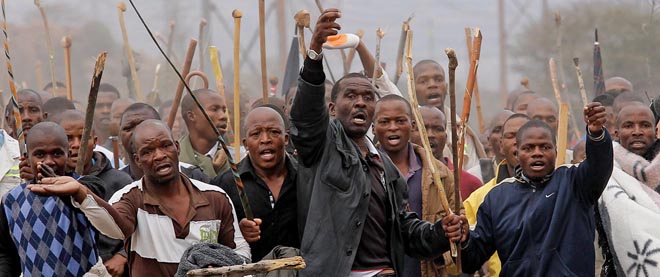South Africa and the Marikana effect
After a strike left 34 dead, one mining firm increased wages by 22 per cent. Could the deal be contagious?
KIM LUDBROOK/Corbis
Share

First, the miners went on strike. Work stoppages swept through South Africa’s platinum, gold, diamond and chrome mines. Now, truckers are off the job, and a municipal workers’ union is poised to walk off, too. The frequency of strikes has spiked since Aug. 16, when police opened fire on workers who had gathered outside a platinum mine in Marikana, killing 34.
In the wake of the incident, Lonmin, a global platinum-mining firm, settled the conflict with a 22 per cent pay raise. Strikes have spread beyond mining. Toyota recently reported a four-day shutdown because of labour disruptions at its factory; and Shell said last week it could not honour fuel-delivery contracts around Johannesburg because of a truckers’ strike. At a city supermarket in the city, the price of apples has jumped 27 per cent since the truck drivers’ strike began.
Last week, Anglo American Platinum Ltd., the world’s largest producer of platinum, fired 12,000 striking workers. The company claims to have lost US$80 million in revenue since striking started. The miners were demanding a monthly salary of $1,800—more than double what some now earn.
The country’s economy has taken a walloping as a result. Moody’s Investors Service cut the nation’s bond rating last month by one notch—from A3 to Baa1—the first downgrade since apartheid. The credit agency cited the government’s inability to deal with economic and political challenges and the challenges posed by “relatively high labour costs despite high unemployment.” The rand, the country’s currency, fell to a 3½-year low against the U.S. greenback. It now takes nearly nine rand to buy one dollar. The strikes have highlighted a growing feeling of inequality in South Africa; many believe the African National Congress government has done much for an elite few and very little for average South Africans.
President Jacob Zuma’s response to the crisis has been criticized as tepid. “We should not seek to portray ourselves as a nation that is perpetually fighting,” Zuma said last week. “We must create a climate of constructive social dialogue, which South Africans are known for.”
Perhaps he is distracted. Zuma, who is running for re-election to the ANC presidency in December, is facing an investigation after spending millions of taxpayers’ dollars renovating his private residence in KwaZulu Natal, complete with a helipad and two Astroturf soccer pitches.
Strikers, meanwhile, have turned to shows of violence, an apparent negotiating tactic, to up their pay. Union leaders publicly condemn it, but non-striking workers, known as amagundwane—a Zulu word for rats—have been targeted. Despite an order issued by a Johannesburg court to stop attacks associated with the transport strike, trucks continued to be torched and stoned last week. In one incident, three people, including a child, were injured. In Cape Town last week, Gary Stewart, a trucker, died after being removed from life support; he’d been hit by a rock thrown by strikers.
How are the mining companies responding? Platinum executives are holding 16 bargaining sessions throughout October with the goal of creating a centralized collective bargaining process to avoid further strikes. “The opportunity should be taken to vent or to show displeasure or anger or resentment with the conduct of other parties around the table,” said talks facilitator Charles Nupen—even “if we get a bit of sweat on the walls.”
Whether there is room for negotiation is questionable. Platinum strike leader Evans Ramokga says the firm will hire new employees “over our dead bodies.” As Tanya Venter, a professional mediator who is working with the striking workers says, “It has shocked our country to the core.”